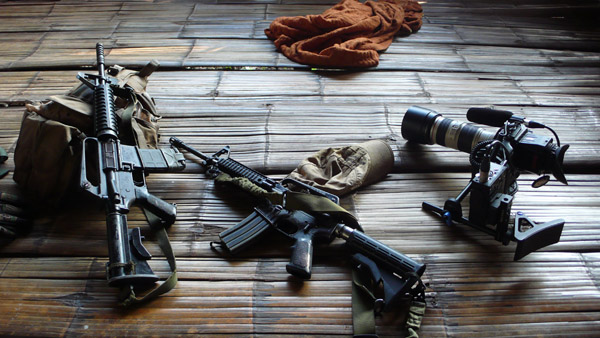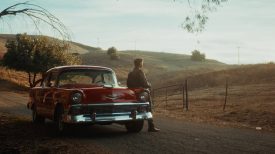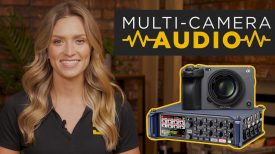Guest post by Andy, Sky News undercover cameraman in Burma.
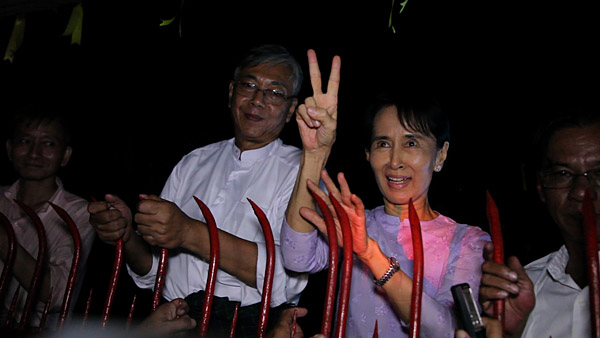
To bring Sky News viewers HD pictures from inside Burma for the release of Aung Sang Suu Kyi was a serious challenge. Foreign journalists and their broadcasting equipment are not welcome. Dodging the authorities was not our only problem. We were also filming rebel militias in the jungle, capturing gun battles – and fighting off the wildlife, like the army of black ants that overran my Macbook Pro as I was frantically editing a video one night.
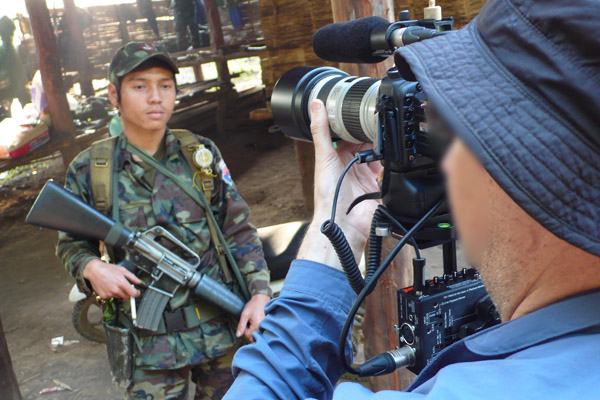
Nine months ago I started watching what The Guardian’s Dan Chung was doing with video from his DSLR in Beijing. I bought a Canon 5D Mkii and spent many hours fine-tuning my newsgathering set up. Not easy with so much misleading nonsense on the internet.
If you want to short cut this article the summary is what you already know: the more control you have over your shoot, the greater your chance of DSLR video success. For random videos set to music the end product using a 5DmkII is often a wow. Failed and missed shots can be glossed over.
But with newsgathering there is often little or no control of your subject. For me the virtue of a 5DmkII is the possibility of a 35mm sensor and HD codec in a compact form. I know the ‘cons’, but in some cases the 5DmkII gives me a chance to shoot HD pictures in places my large Panasonic P2HD ENG camera cannot go. DSLRs are a compromise for video, but for Burma they were the key to getting the only HD pictures.
The first part of Sky’s coverage was crossing illegally into Burma and reporting from inside a rebel army camp. The Karen National Liberation Army (KNLA) have been fighting the longest running military conflict in the world with the ruling Burmese military Junta. Jungle conditions were tough, hot, humid and dusty. I was relieved everything worked; even the 5DmkII bounced back after I dropped it. I teamed my 5DmkII with a Miller DS10 tripod which was silky smooth (though having no illuminated levelling bubble was a pain). I also packed a Kessler Pocket Dolly V2 which also the same length as the tripod when packed , this worked a treat when I had time to use it.
The size of my backpack determined the kit and it had to be easy to access. I had tested dozens of camreabags and the Thinktank Streetwalker hardrive bag turned out to be exactly what I needed.
My Kit includes:
5DmkII with 24-105mm F4L IS and fitted battery grip, 70-200mm F4L IS. Old Zeiss/Contax 25mm F2.8 and 50mm F1.4. Delkin dual battery charger, six Canon batteries, Juiced Link DT454 mixer and 9v batteries, headphones, Zacuto Z-finder, SmallHD DP6 Monitor and ball and socket connector, custom Redrockmicro gunstock rig, six CF cards, Genus Fader ND, Sonnet dual CF card reader, Schoeps shotgun mic and hot shoe bracket. Tram TR-50 lavalier mic, various XLR cables, small F&V light Z96 LED light and ball connector, reflector, 15inch MacBook pro and hard drives. (When I used this as my run bag, the Mac and drives were left at base camp).
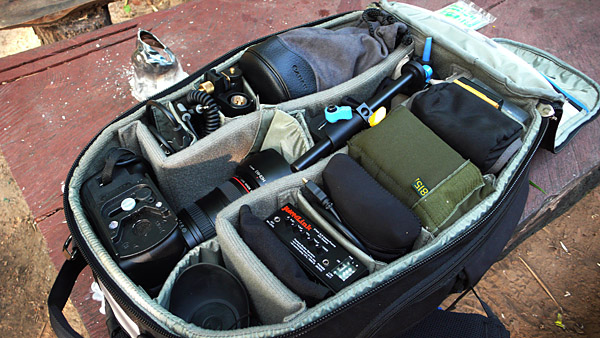
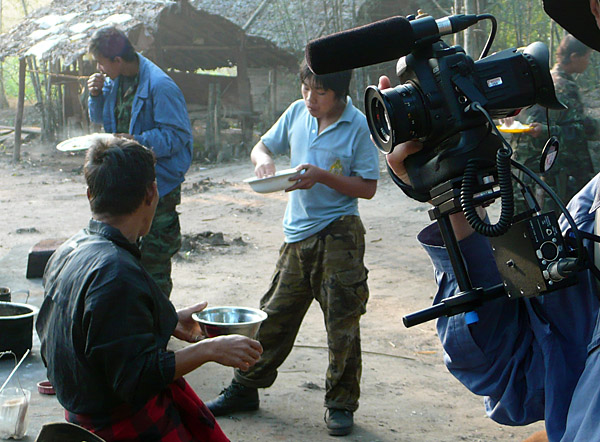
I’d been lucky to try out lots of rig configurations with Dan in Beijing. He has so much DSLR gear that I could test and build my own shoulder brace with parts from many manufacturers. That said I sometimes favoured my large Gorillapod as a shoulder brace. All my kit is fitted with Manfrotto quick release plates to move quickly between set ups. My advice for news is to avoid ridiculous oversized DSLR rigs. The Christmas tree look isn’t practical and you want to be able to turn round in corridors.
I found for me there is little point in having lenses faster than F4. Image stabilizing is the essential factor and Canon lens Image Stabilization is amazing. I have faster Zeiss lenses from Contax; all de-clicked. The manual iris is easier to adjust, but without IS they are very bumpy when hand held. Having to change lenses is a tremendous pain, not just in dusty conditions. I suppose that is why snappers use multiple camera bodies. Still, my pair of Canon zooms covered things very well, though I did miss the longer range of my broadcast Canon HD lens. My least favourite thing was using the essential Canon 5DmkII focus assist and realising that the zoomed in shot I could see on the screen was the one that I wanted, but that I didn’t have the lens to shoot it!
In low light things swing back in favour of the 5D; at times I was pushing the ISO to 5000 and although the picture became grainy it was not noisy in the nasty video gain way. Shooting at F4 with longer lenses still gives an extremely narrow depth of field. Unless your subject is sitting in a Victorian photographer’s neck brace the chances of nailing a shot at F1.4 are slim. The 5DmkII’s LCD screen is good, but the Zacuto Z-finder I found disappointing. Compared to using a proper ENG camera’s viewfinder, following focus and setting exposure are absurdly tricky. I also don’t understand why pro-photographers accept cameras that can only give a low level shot if you lie in the dirt or that require a step-ladder for an angled down top shot. The Zacuto finder doesn’t help here. I think it is over hyped and I’m looking for a better solution. The DP6 monitor is without any doubt the best monitor to use with DSLRs. I’ve tried a few and now use the DP6 on all sit-down interviews if time permits.
We’d carried a lightweight generator into the rebel camp and our first news item I cut and fed overnight with the Mac Book Pro. The jungle insects decided my Mac screen and the light reflected in my face were the only party in town. At one point a black sea of ants erupted from the ground and overran the Mac. All credit to the Mac for not giving up under the insect invasion. Capture times to Prores LT with Final Cut Pro 7 are poor at more than twice real time. It’s fair to say I’m not an FCP fan as I have the misfortune to be regularly using it with my wonderful P2 camera, where again FCP is the least compatible NLE system. In contrast the Livewire M-link X system we use for compressing our footage is fantastic. Even using fast 4MB 2 pass encodes the resulting picture quality is extremely high and the file sizes manageable for transmission over our BGAN satellite dishes.
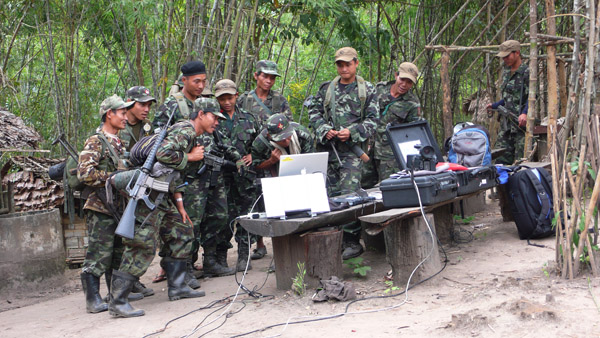
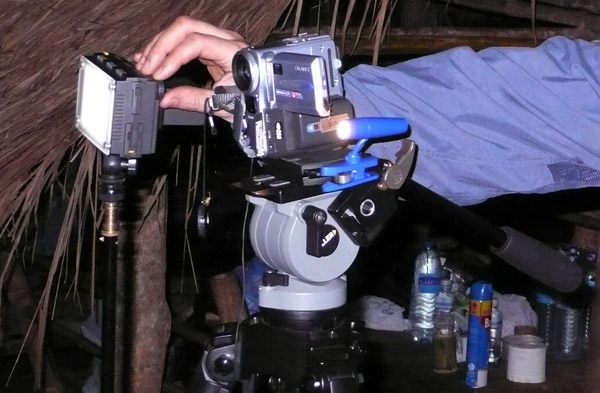
I confess we used a regular DV camcorder to do our videophone lives; including in night vision mode after dark. The Streambox live software in our MacBook Pros requires the use of a firewire connector, which the Canon 5DmkII does not have.
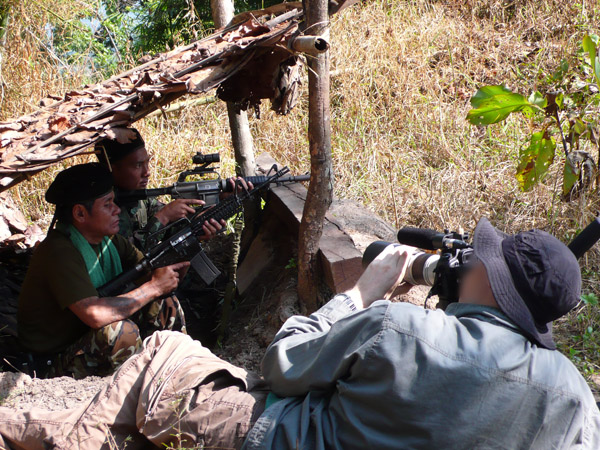
We stayed on in the jungle camp, doing more candlelit live broadcasts and sleeping in hammocks. I shot a second package for the Sunday Burma elections. Then we got news of fighting breaking out at Myawaddy four hours to the South. We raced to the frontline and did more ‘lives’, taking cover under Friendship Bridge. I did a few excursions to record the gun battles on the other side of the river with the 5DmkII. In one of these the Juicedlink DTD454‘s output mini jack got knocked. I was monitoring with headphones and meters on the DT454, but sadly the output socket had broken and gave only intermittent sound to the 5DmkII. I was lucky we got a piece to camera out and some of the gun fight, but I could do nothing but weep when I later realised the entire sequence of thousands of refugees streaming away from the fighting was mute. Audio is the issue with the 5D and it’s no joke when things go wrong with rounds whizzing past your ears. (Robert Rozak of Juiced Link tells me the design is changing to make the minijack sockets more secure. For me I really want them to be bolted to the metal case of the unit to be one hundred percent safe.)
My trusty Tram 50 tie mic had been ripped in two by a heavy handed rebel commander, so I was down to my spare cheap Chinese tie mic on 5m of cable plugged directly into the camera. Manual sound was now seriously handicapped with no way to monitor sound at all.
Part two of our Burma assignment was the main event; teaming up with a second Sky crew for the release of Aung Sang Suu Kyi in Rangoon. Duncan, the other Sky cameraman, also used his Canon 5DmkII. In Rangoon all the international media were there illegally. It had been difficult getting in and everyone was on edge. All the other broadcasters were using mini-sized palmcorders and our 5DmkII’s were definitely going to give us better pictures if we could pull it off.
Duncan and I posed as tourists with our cameras and dodged the military intelligence and plain clothes police who were on the streets in large numbers. It was an extremely nervous wait. We changed hotels and guesthouses every day and sweated it out hiding in the backs of clapped-out taxis.
Sky is a 24 hour news channel and the newsroom wanted live broadcasts when ever we could pull them off. This meant a lot of skulking around at night and surreptitiously setting up rooftop BGAN satellite links so we could film our reporter live – in night vision mode. We couldn’t name our reporters and were constantly aware of the risk of being caught and thrown out of the country ahead of Suu Kyi’s release.
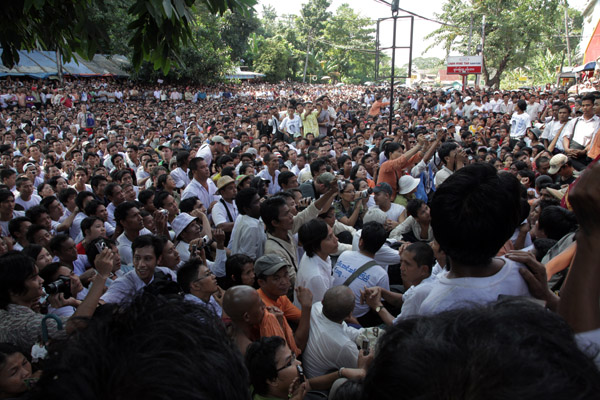
In the end we triumphed as Sky News was the only international news team to show in HD as thousands of Suu Kui supporters streamed through the streets of Rangoon and gathered in jubilation as she appeared at her gates for the first time. I had run with my gear three kilometres to her house with her supporters pushing past the police barricades. I was very glad I was holding a lightweight 5DmkII. As Suu Kyi stood up above her gate the crowd surged. I ramped up the ISO, switched on my Z96 LED and as Suu Kyi stood up I was literally lifted off my feet as the cheering crowd surged forward in euphoria. You could see the elation in Suu Kyi’s eyes as she calmly waved and smiled back at her adoring supporters. I thought to myself how amazing it was such a moment was lit by a small and inexpensive LED light!
The flood of appreciative emails from our viewers confirmed the decision to use 5DmkIIs had paid off. The image quality was outstanding, although I personally can’t ignore the flash banding, which, though it looked shocking in the viewfinder, wasn’t remarked on by our audience. Duncan cut our first piece in forty minutes and the clarity of the pictures took our viewers one step closer to being there and witnessing history as it happened.
The next day we waited for Suu Kyi’s first press conference. We’d got inside the National League for Democracy party offices and I fretted anxiously waiting for Suu Kyi’s arrival. She had to walk up a dark narrow staircase surrounded by supporters and we had to get her first words. At F4 with a Canon 5DmkII this was a moment to hold your nerve. Suu Kyi arrived and we pulled off a doorstep interview with her and followed her into her first meeting with foreign diplomats. Later her press conference was an unbelievable scrum of supporters and press. I got a good position and my correspondent held the tie mic close to Suu Kyi. About half way through the presser my mini jack cable was torn in half by the force of the scrum. I removed the minijack from the 5D and we recorded the remainder of the presser on top mic alone. Fortunately we’d done a piece to camera earlier among the crowds of supporters outside.
Saying shooting video on a stills camera is a compromise is a bit of an understatement. Duncan was using a Tascam DR-100 audio unit to record sound separately for voiceover and without it we would have been in trouble. I still want to record audio direct to the 5DmkII CF card so I can be better placed to do quick edits without the need to find and sync separately recorded SD audio files.
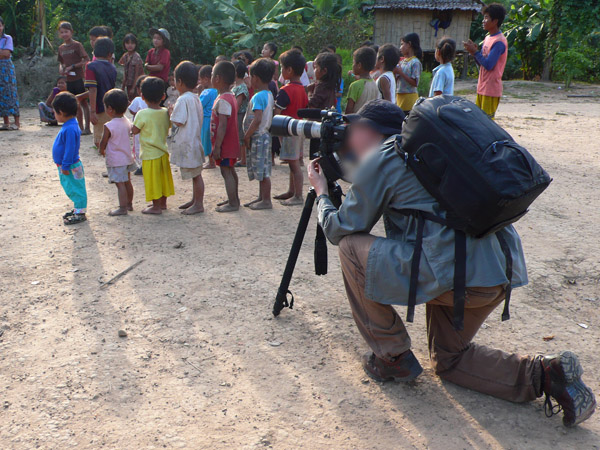
The Canon 5DmkII has been a stick of dynamite to the broadcast manufacturers. Panasonic’s AF100 looks like my natural next stop and future offerings from Canon and the rest are eagerly anticipated. I still have a nagging feeling using a DSLR is like tweaking extra miles per gallon from a BMW diesel and perhaps I should be throwing myself into the future shooting 3D video. Just remind me: How do we guide our audiences eyes with 3D if everything is in focus from here to Mongolia?

